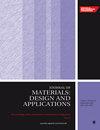Synchrotron EDXRD strain-temperature measurement during laser welding
IF 2.2
4区 材料科学
Q3 MATERIALS SCIENCE, MULTIDISCIPLINARY
Proceedings of the Institution of Mechanical Engineers, Part L: Journal of Materials: Design and Applications
Pub Date : 2024-05-06
DOI:10.1177/14644207241249765
引用次数: 0
Abstract
Localised heat input, as it occurs in welding with moving heat sources, induces residual stresses and distortion in materials. The quantitative determination of residual stress evolution is difficult. Despite existing models, residual stress build-up with temperature progression is not fully understood. High-flux density X-rays from a synchrotron source allow the measurement of local strains in materials and improve the resolution of stress gradients as it permits small measurement volumes (Gibmeier et al., 2014). A laser beam welding process was used to perform linear bead-on-plate welds on bar steel samples. The X-ray diffraction system recorded the transient strain evolution. Multiple repetitions at different locations in the specimen were combined to develop a map of the strains present within the specimen. The temperature was measured locally at the surface of the sample. As the strain was determined within a measurement volume inside the sample, the temperature history over time had to be obtained as well. A numerical model was employed to determine the temperature inside the measurement volume. This model was calibrated using the transient surface temperatures and metallographic cross-sections. The result was a representation of the local strain superimposed on the temperature distribution. Analysis of this data correlation showed that a strain maximum occurs as a function of time and distance from the heat source, which is likely to coincide with the austenite-ferrite phase transformation temperature.激光焊接过程中的同步辐射电子能谱 X 射线衍射应变-温度测量
局部热输入(如在使用移动热源进行焊接时)会在材料中产生残余应力和变形。残余应力演变的定量测定非常困难。尽管已有模型,但人们对残余应力随温度升高而增加的情况还不完全了解。同步辐射源发出的高通量密度 X 射线可以测量材料中的局部应变,并提高应力梯度的分辨率,因为它允许小体积测量(Gibmeier 等人,2014 年)。利用激光束焊接工艺对棒材钢样品进行线性焊缝焊接。X 射线衍射系统记录了瞬态应变演变。结合试样不同位置的多次重复,绘制出试样内部的应变图。温度是在试样表面局部测量的。由于应变是在试样内部的测量体积内测定的,因此还必须获得随时间变化的温度历史。采用数值模型来确定测量体积内的温度。该模型使用瞬态表面温度和金相横截面进行校准。结果是在温度分布上叠加了局部应变。对这一数据相关性的分析表明,应变最大值是时间和与热源距离的函数,很可能与奥氏体-铁素体相变温度相吻合。
本文章由计算机程序翻译,如有差异,请以英文原文为准。
求助全文
约1分钟内获得全文
求助全文
来源期刊

CiteScore
4.70
自引率
8.30%
发文量
166
审稿时长
3 months
期刊介绍:
The Journal of Materials: Design and Applications covers the usage and design of materials for application in an engineering context. The materials covered include metals, ceramics, and composites, as well as engineering polymers.
"The Journal of Materials Design and Applications is dedicated to publishing papers of the highest quality, in a timely fashion, covering a variety of important areas in materials technology. The Journal''s publishers have a wealth of publishing expertise and ensure that authors are given exemplary service. Every attention is given to publishing the papers as quickly as possible. The Journal has an excellent international reputation, with a corresponding international Editorial Board from a large number of different materials areas and disciplines advising the Editor." Professor Bill Banks - University of Strathclyde, UK
This journal is a member of the Committee on Publication Ethics (COPE).
 求助内容:
求助内容: 应助结果提醒方式:
应助结果提醒方式:


